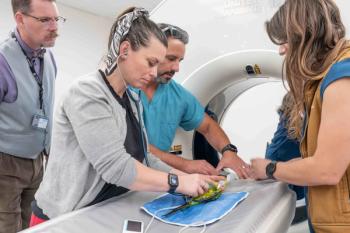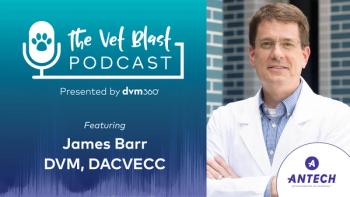
Case 13
You discuss your concerns with the owner regarding the small liver and abnormal laboratory findings. And given Olivia's age, you suspect that she may have a portosystemic shunt, so you recommend an abdominal ultrasonographic examination and pre- and post-prandial bile acid assay. The owner agrees to fast Olivia overnight and return the next day for testing. These are her test results:
Abdominal ultrasonographic examination
An extrahepatic shunt vessel (4.5 mm in diameter) is identified between the portal vein and caudal vena cava. The liver mass appears decreased overall, but the parenchyma appears normal. Subjective assessment suggests portal hypertension is not apparent. The urinary bladder contains multiple small uroliths.
Serum bile acid assay
Pre-prandial = 95 µmol/L (normal < 13 µmol/L)
Post-prandial = 150 µmol/L (normal < 25 µmol/L)
You explain to the owner that an extrahepatic portosystemic shunt (PSS) is causing Olivia's clinical signs. PU/PD is a common finding with this condition, although the mechanism is unclear. Decreased urea production and subsequent decrease in the renal medullary concentration gradient as well as psychogenic polydipsia from encephalopathic toxins may play a role. While hyperammonemia is thought to be a common reason for the development of hepatic encephalopathy, other metabolic disturbances are likely. Endogenous benzodiazepines, altered manganese metabolism, and inflammation have also been implicated.
The uroliths identified on abdominal ultrasonographic examination are likely the cause of Olivia's dysuria and mild abdominal discomfort. These were not noted on the abdominal radiographs so are consistent with radiolucent ammonium urate stones that form due to decreased urea production, increased ammonia excretion, and decreased uric acid metabolism. Olivia's hyposthenuria is likely secondary to the polydipsia, although isosthenuria can sometimes be identified because a poor medullary concentration gradient can occur as a result of a deficient urea cycle.
Microcytic anemia is also a common finding in dogs with portosystemic shunts. Studies suggest this may be due to a defective iron-transport mechanism, decreased serum iron concentrations, or decreased total iron-binding capacity.
While elevations in liver enzyme activities in dogs with PSSs are not uncommon, it is important to note that the ALT activity may wax and wane and that dogs with PSSs may have normal serum chemistry profile results.
While some studies have shown that pre- and postprandial bile acid assays are 100% sensitive for the diagnosis of PSS, it is important to remember that bile acid assay results can be normal in patientswith PSS and can even vary day to day. Problems such as delayed absorption, lack of gallbladder contraction due to inadequate food intake, or malabsorption or maldigestion may result in lower than expected concentrations. In cases in which the bile acid assay results are inconclusive, a fasting serum ammonia concentration or a urine bile acid:creatinine ratio (if serum BUN and creatinine concentrations are normal) can be considered. This urine test has a low sensitivity but high specificity (few false positive results) for the diagnosis of hepatic disease.
QUESTION 5
Now that you have a diagnosis of PSS, what is your treatment plan for Olivia? (There is more than one correct answer.)
b)
c)
<<
Newsletter
From exam room tips to practice management insights, get trusted veterinary news delivered straight to your inbox—subscribe to dvm360.






